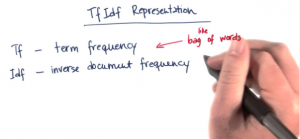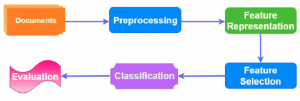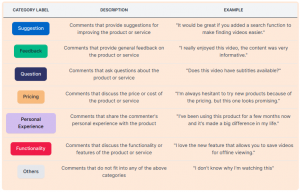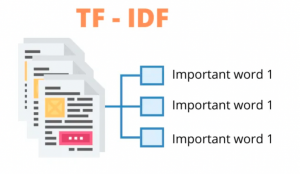In a world increasingly driven by data and information, text classification stands as a fundamental pillar of natural language processing. Whether you’re browsing through your social media feed, searching for the perfect recipe online, or sifting through your email inbox, text classification plays an invisible yet pivotal role in organizing and understanding the deluge of textual data. One of the key techniques that underpin text classification is TF-IDF, a concept that bridges the gap between words and their meaning in the realm of machine learning and artificial intelligence.
TF Meaning: Unveiling the Essence of Term Frequency
Before we delve into the intricacies of TF-IDF and text classification, let’s start by deciphering the meaning of “TF.” TF, or Term Frequency, is a foundational concept in the world of text analysis. It quantifies how frequently a term or word appears in a document. Essentially, it answers the question: How often does a specific word occur in a given text? Term Frequency is a fundamental building block that aids in understanding the significance of words within a document.
Imagine you’re analyzing a collection of news articles, and you want to determine the most important terms in each article. Term Frequency allows you to count how many times a particular word appears in a given article. This information can be invaluable in various applications, from keyword extraction for search engine optimization to sentiment analysis in customer reviews.

TF-IDF: The Magic of Term Frequency-Inverse Document Frequency
“In the age of information, ignorance is a choice.” – Donny Miller
Now that we’ve grasped the importance of Term Frequency, it’s time to introduce its counterpart: Inverse Document Frequency or IDF. IDF is a measure that evaluates the rarity or uniqueness of a term across a collection of documents. It aims to identify words that are distinctive and carry more weight in differentiating documents from one another.
TF-IDF, or Term Frequency-Inverse Document Frequency, is the synergy between these two concepts. It’s a numerical statistic that combines TF and IDF to gauge the importance of a term within a specific document relative to its frequency across all documents in a corpus. In other words, TF-IDF helps us identify the words that are not only frequent within a document but also have a distinctive presence compared to the entire document collection.
Consider a scenario where you’re building a recommendation system for books based on user reviews. TF-IDF can identify the key terms in each review, highlighting those that are unique to certain books and thus aiding in more accurate recommendations.
TF-IDF Matrix: Transforming Words into Numbers
To apply TF-IDF effectively, we transform our textual data into a numerical format that machine learning algorithms can process. This transformation is achieved through the creation of a TF-IDF matrix. The TF-IDF matrix represents documents as rows and terms as columns, with each cell containing the TF-IDF score of a term in a specific document.
Imagine a library filled with books, each book representing a document, and words from the entire collection forming the columns of a gigantic spreadsheet. The TF-IDF matrix allows us to quantify the importance of each word in each document, providing a structured representation of our textual data.
This matrix is not just a set of numbers; it is the foundation on which text classification techniques and machine learning algorithms operate. It enables us to measure textual similarity, identify significant terms, and ultimately classify and categorize documents based on their content.
Term Frequency: Counting the Language of Data
To truly comprehend the power of TF-IDF, it’s essential to delve deeper into Term Frequency (TF), the “TF” in TF-IDF. As previously mentioned, TF quantifies how often a term appears within a document. It’s a simple yet critical concept that serves as the basis for many text analysis tasks.
In practice, TF is calculated using a straightforward formula:

This formula provides us with a numerical representation of how frequently a term occurs in a specific document. The resulting TF values allow us to compare and rank terms within a document, revealing which words hold the most significance in conveying the document’s meaning.
For instance, in a customer review for a restaurant, a high TF value for the term “delicious” might indicate that the review speaks positively about the food, making it a crucial keyword for sentiment analysis.
Document Classification: Sorting the Chaos
In our information-driven world, where data is generated at an unprecedented rate, the need for effective document classification has never been greater. Document classification, also known as text classification, is the process of automatically assigning predefined categories or labels to textual documents. This task is indispensable in organizing, managing, and extracting valuable insights from vast collections of textual data.
Consider an email filtering system that categorizes incoming messages into “inbox,” “spam,” or “promotions.” Or think about a news aggregator that classifies articles into topics like “politics,” “sports,” or “entertainment.” These are just a few examples of how document classification plays a pivotal role in our daily digital interactions.

Text Classification Techniques: Beyond Keywords
“The limits of my language mean the limits of my world.” – Ludwig Wittgenstein
Text classification is a multidimensional problem with a myriad of techniques and approaches. It’s not merely about identifying keywords or phrases; rather, it involves understanding the context, semantics, and relationships between words within a document.
Some popular text classification techniques include:
- Naive Bayes Classifier: This probabilistic algorithm is based on Bayes’ theorem and is particularly effective for sentiment analysis and spam detection.
- Support Vector Machines (SVM): SVM is a powerful machine learning algorithm that excels in classifying documents into multiple categories.
- Deep Learning Models: Neural networks, including Convolutional Neural Networks (CNNs) and Recurrent Neural Networks (RNNs), have gained prominence in text classification, enabling more nuanced understanding of textual data.
- Word Embeddings: Techniques like Word2Vec and GloVe create dense vector representations of words, capturing semantic relationships, which can improve classification accuracy.
- Ensemble Methods: Combining the predictions of multiple classifiers, such as Random Forests or Gradient Boosting, often leads to enhanced classification performance.
Text classification is not a one-size-fits-all task. The choice of technique depends on the nature of the data, the desired level of accuracy, and the specific use case. It’s a domain where the art of feature engineering, the science of algorithm selection, and the power of data come together to solve complex problems.
Text Classifier: Bridging Language and Machines
“Language is the dress of thought.” – Samuel Johnson
At the heart of text classification lies the text classifier—a sophisticated piece of machinery that interprets the nuances of human language and translates them into machine-understandable patterns. A text classifier takes as input a text document and assigns it to one or more predefined categories based on the content of the text.
To create a text classifier, several steps are involved:
- Data Preparation: This step includes data cleaning, preprocessing, and splitting the data into training and testing sets.
- Feature Extraction: Textual data must be converted into numerical form. TF-IDF is a common technique for this purpose.
- Model Selection: Choosing an appropriate text classification algorithm or model is crucial. This depends on the nature of the task and the dataset.
- Training: The model is trained on the labeled training data, learning the patterns and relationships between words and categories.
- Testing and Evaluation: The model’s performance is assessed on a separate set of data to ensure it generalizes well to unseen examples.
- Deployment: Once the model performs satisfactorily, it can be deployed in real-world applications to automate document classification.
Text classifiers are the unsung heroes behind the scenes of many AI-driven applications, from spam filters in emails to content recommendation systems on streaming platforms. They enable machines to understand and organize textual information with human-like accuracy.

Machine Learning Algorithms Explained: The Brains Behind Text Classification
Text classification wouldn’t be possible without the machine learning algorithms that power it. These algorithms serve as the cognitive engines that process and interpret the language hidden within textual data. Let’s explore a few key machine learning algorithms commonly used in text classification:
- Naive Bayes: Based on Bayes’ theorem, this algorithm is known for its simplicity and effectiveness in tasks like spam detection and sentiment analysis.
- Support Vector Machines (SVM): SVMs are versatile classifiers that can handle binary and multiclass classification problems. They work by finding a hyperplane that best separates data points into different classes.
- Random Forest: An ensemble learning method, Random Forest combines multiple decision trees to make predictions. It is robust and can handle large feature sets.
- Neural Networks: Deep learning models like CNNs and RNNs have revolutionized text classification. They excel in tasks where understanding context and semantics is essential.
- Logistic Regression: Despite its name, logistic regression is a linear model used for binary classification. It’s simple and interpretable, making it a popular choice for certain applications.
- Gradient Boosting: Algorithms like XGBoost and LightGBM are widely used for text classification due to their ability to handle large datasets and complex feature spaces.
The choice of algorithm depends on the specific requirements of the text classification task. Some algorithms may perform better with short, structured text, while others excel with longer, unstructured documents. Machine learning algorithms, coupled with TF-IDF and other text preprocessing techniques, provide the necessary tools to extract meaning from the written word.
Text Analysis Free Online: Tools for the Masses
The field of text analysis has witnessed significant growth in recent years, driven by the increasing availability of online tools and resources. These tools democratize text analysis, making it accessible to a broader audience, from students and researchers to businesses and hobbyists. Here are some popular online tools that facilitate text analysis:
- NLTK (Natural Language Toolkit): NLTK is a Python library that provides a comprehensive suite of libraries and programs for natural language processing. It’s an invaluable resource for text analysis tasks like tokenization, stemming, and more.
- TextBlob: TextBlob is a simplified Python library built on NLTK and Pattern. It offers an intuitive API for common text processing tasks, including sentiment analysis on social media comments, part-of-speech tagging, and translation.
- TfidfVectorizer (Scikit-learn): Scikit-learn, a popular machine learning library, includes a TfidfVectorizer that simplifies the process of converting text data into TF-IDF matrices. It’s a go-to tool for many text classification projects.
- Google Cloud Natural Language API: For more advanced text analysis tasks, Google Cloud’s Natural Language API offers features like entity recognition, sentiment analysis, and content classification.
- IBM Watson Natural Language Understanding: IBM’s offering provides a wide range of text analysis capabilities, from sentiment analysis and emotion detection to entity recognition and concept extraction.
These online tools and libraries have lowered the barrier to entry for text analysis, enabling individuals and organizations to extract valuable insights from text data without the need for extensive coding and infrastructure.
Text Classifier Tool: Your Gateway to Automation
In the age of automation, text classifier tools have emerged as indispensable assets for businesses seeking to streamline operations, improve customer service, and make data-driven decisions. These tools are designed to automate the process of categorizing and organizing textual data, saving time and resources.
Consider a customer support department inundated with emails and messages. A text classifier tool can automatically route customer inquiries to the appropriate teams based on the content of the message. Similarly, a content aggregator can use text classifiers to categorize news articles or blog posts, making it easier for readers to find relevant content.
The implementation of text classifier tools not only enhances efficiency but also enables organizations to harness the full potential of their data. With the power of AI and machine learning, these tools continuously learn and adapt to new patterns, ensuring accuracy and reliability in text classification tasks.
Text Categorization: Sorting the Information Deluge
Text categorization, often used interchangeably with text classification, is a broader concept that encompasses the organization and labeling of textual data into predefined categories or classes. In essence, it’s about taming the information deluge by categorizing text into meaningful groups.
Imagine a scenario where a news aggregator must categorize articles into topics such as “politics,” “technology,” “sports,” and more. Text categorization algorithms, powered by techniques like TF-IDF, machine learning models, and deep learning, make this task feasible on a large scale.
For instance, we have provided these classes in our comments categorization services as below:

Text categorization is not limited to news articles; it finds applications in email filtering, content recommendation, legal document classification, and sentiment analysis, to name just a few. As our digital world continues to generate vast amounts of text, text categorization becomes increasingly crucial for effective information retrieval and management.
Text ML: The Intersection of Language and Machines
The convergence of language and machine learning is at the heart of Text ML (Text Machine Learning). Text ML represents the cutting edge of natural language processing, where algorithms and models are trained to understand and interpret text in ways that mimic human language comprehension.
Text ML applications are diverse and far-reaching:
- Sentiment Analysis: Analyzing social media data to gauge public sentiment towards products, services, or political events.
- Chatbots and Virtual Assistants: Developing conversational agents that can understand and respond to user queries in natural language.
- Language Translation: Building systems that can translate text from one language to another with high accuracy.
- Content Recommendation: Recommending personalized content to users based on their reading habits and preferences.
- Text Summarization: Automatically generating concise summaries of long texts, saving time for readers.
- Named Entity Recognition: Identifying and categorizing entities like names, dates, and locations within text data.
Text ML is at the forefront of innovation, shaping the way we interact with machines and the capabilities of artificial intelligence. As it continues to evolve, the boundaries of what machines can accomplish with text data are constantly expanding.
Vectorize Text: Transforming Words into Vectors
In the realm of natural language processing, words are not just strings of characters but vectors of meaning. Vectorization is the process of converting words and documents into numerical vectors that can be processed by machine learning algorithms. This transformation is a critical step in various text analysis tasks, including text classification.
There are multiple techniques for vectorizing text, each with its advantages and use cases:
- One-Hot Encoding: In this approach, each word is represented as a binary vector, with a “1” in the position corresponding to the word’s index in the vocabulary and “0s” everywhere else.
- Count Vectorization: This technique creates vectors where each element represents the count of a word’s occurrence in a document.
- Word Embeddings: Word embeddings, such as Word2Vec and GloVe, generate dense vector representations of words, capturing semantic relationships between them.
- TF-IDF Vectorization: TF-IDF, as discussed earlier, represents words in documents as numerical vectors based on their importance and frequency.
Vectorization enables machines to understand the contextual relationships between words, paving the way for more sophisticated text analysis techniques and enhancing the accuracy of text classification.

Conclusion: Words that Shape the World
“Language is the most massive and inclusive art we know, a mountainous and anonymous work of unconscious generations.” – Edward Sapir
In a world overflowing with text, from social media conversations to academic research papers, the ability to extract meaning and make sense of the written word has never been more crucial. Text classification, powered by the TF-IDF technique and a range of machine learning algorithms, stands as the bridge between human language and artificial intelligence.
As we navigate the vast landscape of text analysis, from the meaning of Term Frequency to the intricacies of text vectorization, we unlock the potential to automate tasks, gain insights, and make data-driven decisions. From chatbots that understand our queries to recommendation systems that anticipate our preferences, the applications of text classification are virtually limitless.
In the words of Arthur C. Clarke, “Any sufficiently advanced technology is indistinguishable from magic.” Indeed, the magic of text classification lies in its ability to transform words into actionable insights, enabling us to explore, understand, and harness the power of language in the digital age. As we continue to push the boundaries of what’s possible in text analysis, one thing remains clear: the words we use shape the world we live in, and with the right tools and techniques, we can unlock the true potential of the written word.
informative post! amazing
Whenever you will be conducting business in any specific locale or metropolis and delivering items or facilities, spending in SEO is one of the foremost ways to boost your business. That’s because it can channel potential consumers immediately to your webpage when they browsefor what you may be providing.
https://gotwebsite1.com/tempe-seo/
Streaming Site Domination with Specialist Search word Investigation Tactics 87337c3
And what are the advantages of engaging skilled Search Engine Optimization
agencies? Skilled search engine marketing companies utilize crews of experts focused on boosting your website’s content for searching engines. This includes exploringkeyword combinations, adjusting on site components, and managing away from the site
enhancements. Additionally, these firms monitor adjustment in by Google
rules and revise your website material
when needed. This saves you your time and your staff of unwanted stress.
Monthly SEO packages for little businesses in Scottsdale
CTR Raising Advices through Specialist Meta Tags Improvement f1292f5
For starters, simple sophistication is all about locating the right balance in between simplicity and fanciness. Think clean lines and a amazing look that never goes out of style.
Let us jump into glistening touches. They are like modern finishing which makes wooden floors look really chic. Imagine how the illumination plays on these floors, turning your place into a super trendy showcase of contemporary design.
For the design enthusiasts, how does minimalist elegance add a touch of elegance to your areas? Will you be into the simple yet stylish vibe of metallic finishes in your choice of flooring? Share your thoughts and let’s chat about these trendsetting styles.
By recognizing these building trends, you can get a glimpse into exactly how our style choices can change our living places. Be a part of the discussion as we will consider the outs and ins of these types of fads and exactly how they affect the ways our homes appear.|Gday design and style followers! Immerse yourself in the realm of engineered flooring, where we explore the latest trends altering our living quarters. Your hardwood flooring is more than just a solid foundation; they hold the key to timeless elegance. A significant trend is the emergence of creative coatings, enhancing both the visual appeal and lifespan pertaining to your flooring, offering a long-lasting renovation.
let’s delve into the center of inventive concepts and integrating innovative smart features. Picture floors adjusting to your way of life, responding to temperature fluctuations, offering adjustable lighting choices, and even notifying you of possible upkeep requirements. It’s the right balance of aesthetics and functionality, adding a hint of tomorrow to your living space. Did you know that hardwood floors are not only beautiful but also non-harmful to the environment? Wooden can be renewed, transforming it into an environmentally conscious selection for those who care about the environment. Plus, it can be refinished, prolonging its lifespan and minimizing the necessity for a new one. Participate in the talk and express your opinions on these fascinating trends. Prepared to improve your dwelling with the timeless charm and progress in the hardwood flooring industry?|Let us explore two important trends in wooden floorboards and/or the evergreen fascination of wood with a dark finish and the creative opportunities with adaptable designs. Deep-toned wood flooring adds a hint of sleek modern style and a touch of intrigue to your living environment. Picture rooms flooded There’s a touch of fanciness that makes them stand out., thanks to deep and opulent hues that build a style that’s universally attractive and contemporary feel.
Embrace the timeless appeal of diagonal stripes and panel flooring. and Incorporate a lively and mathematical addition to your home environment, giving a different view on providing a new outlook. From spanning classic and modern styles , Arrowhead and wood tile patterns combine regional and cultural impacts, designing living quarters that entice to a diverse array of tastes. Let us know your perspective sharing your thoughts on the allure of dark wood|Commence on a expedition into a collective ardent to the comprehensive examination of floor materials, where each thread is a entry into the area of unchanging attractiveness. Join in in interactions embracing from the pragmatic features of fixing and maintenance to the aesthetic thoughts of hardwood floor design. Whether you’re charmed to the weather-beaten appeal of used wood or the contemporary allure of spacious-panel hardwood, our platform invites devotees with various palates. Communicate your insights on the robustness of pecan hardwood, the unique motifs of parquet inlaid, or the environment-friendly result of sustainability-certified choices. This territory is a mixture pot of understanding, where neophytes and experts just as unite to decode the enigmata of floor systems tendencies and techniques.|A top prime Experts in Hardwood Flooring Installation is Now providing Skilled in assistance in Redoing hardwood flooring.
We are happy to bring this advantageous benefit to our buyers. said Chloe Adams, Our business owner and advocate for Blackhawk Flooring, Co..
Carter, a Validated Domestic Manufactured Timber Floor and Oak Wood Floor EFTD Seasoned in the art of revitalizing wood floors., Signaled the significance of evaluating hardwood floorboards to assess The requirement for floor renewal. The analysis method Empowers experts to determine Matters like Mistaken humidity content especially during assembly or Picking the mistaken Binding substances.
Here are numerous elements that can cause the damage of a hardwood floor, typically stemming from multiple causes. noticed Brown, having accumulated years of valuable knowledge of professional background and systematic coaching. Acquiring a person with hands-on skills and official instruction is essential.
Blackhawk Flooring Vows purchasers that their appraisal process will meticulously respond to the concerns raised by the customer without prejudice.
We steer clear of take part in a seeking for difficulties with the ground, nor do we distort our findings in favor of one participant over the other, prioritizedGarcia. Our conclusions are guided by data, and we make an effort to compile thorough news about the surface during the scrutiny
Besides, applying its specialized skills, Blackhawk Flooring Store has incorporated sustainable and green practices, at the moment using VOC-free cements that are eco-friendly, supplying customers with a more secure and more eco-friendly decision.
The company gives a diverse assortment of merchandise, including Wooden Flooring, Engineered Wood Flooring, Recycled Wood, Wooden Wall Panels, Luxury Vinyl Wood Flooring, Prime Waterproof Flooring, and additional.
Peterson accentuated that the assessment method, combined with Blackhawk Floors’ extending over a wide area wooden floor showroom boasting with over 773 samples, enables the organization to systematically decide the issues and their origins.
This company has esteemed certifications from the NWFA, which include Certified Installer, Certified Sand & Finisher, and Certified Wood Flooring Inspector.
inspect closely Risers for wooden stairs looks trends in consideration of the unified appearance in Mesa
Nail-down flooring trends for a traditional look in Scottsdale
Discovering Worn Timber Floors: An Timeless Look with Antique Appeal 2261d55
Insightful piece